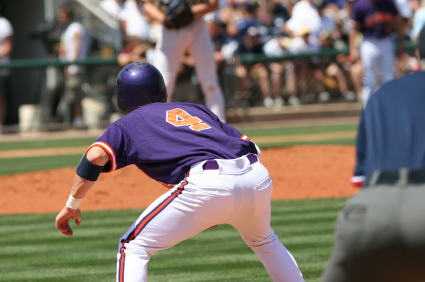The Situation:
A left-handed pitcher has developed the yips when throwing to 1st base. After several disastrous attempts to throw to first, his coach has told him simply not to do it. Word has spread on the scouting reports around the league that the pitcher never picks over, and this weeks’ competition looks to take advantage of it.
After having the leadoff speedster reach base in the top of the 1st, he is still stuck on 1st with 2 outs. The coach knows the pitcher will not throw over, so he tells the runner to extend his lead and steal second.
The Play:
On an 0-1 count, the runner does as instructed. He takes a big lead at first and readies himself to steal the base. The pitcher comes set. He takes a long look at the runner at first before picking up home. He checks the runner again, creating a long hold. The runner starts to get a little tense and jumpy. When the pitcher picks up home, he jumps a little. When the pitcher doesn’t immediately deliver, the runner retreats to his starting position. The pitcher finally delivers the ball to home in a modified leg lift and the runner takes off from first.
The Outcome:
The runner is fast, but his jump was poor after having to reset from jumping out too early. The lefty delivers the fastball to home quickly in 1.15 seconds. The catcher comes up firing and puts the ball waist high over the bag at a 2.1 pop-time. The throw arrives in plenty of time for the covering shortstop to put the tag down. The runner is out and the inning is over.
What Went Wrong:
There are a few things that went wrong, starting with the offensive coach. Even though the pitcher can’t throw over to first, it doesn’t mean that he will be easy to run on. In fact, the pitcher and his coach have come up with a very good plan to combat the pitcher’s weakness. They have worked diligently on holding runners, using long holds and mixing looks. Additionally, they have realized that if the pitcher can deliver the ball to home in 1.2 seconds or less, and their catcher can deliver the ball to second in 2.1 or less, the runner must not only be fast but get a great jump. Getting to second in less than 3.3 seconds on a steal is no easy task (for comparison, Billy Hamilton has been clocked anywhere from 3.0-3.1 seconds), and the offensive coach has failed to take these things into consideration. Sometimes when something is unorthodox, like not being able to pick to 1st, people assume they can exploit it, despite evidence to the contrary. Just because the lefty can’t pick over doesn’t mean that he can’t hold runners and control the run game. This is not only poor homework on the offensive coach’s part, but great job of overcoming weaknesses and focusing on strengths on the part of the pitcher and defense—a tremendous game plan.
The second mistake is the base runner’s. After he jumps out early and is forced to retreat, he has jeopardized his momentum and jump as the pitcher delivers, he should know to shut down the steal attempt, especially after he gets a poor jump the first few steps. Nothing is lost by taking a few hard steps, realizing the odds are not good, and transitioning to a secondary lead. After getting thrown out, he will learn from his mistakes and think the game at a higher level next time.







